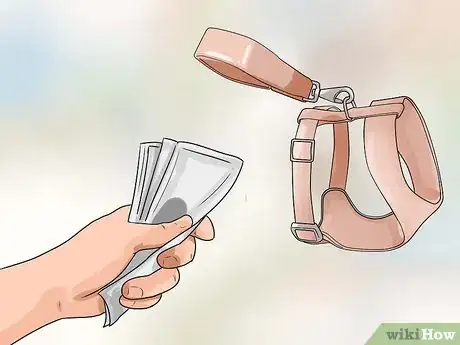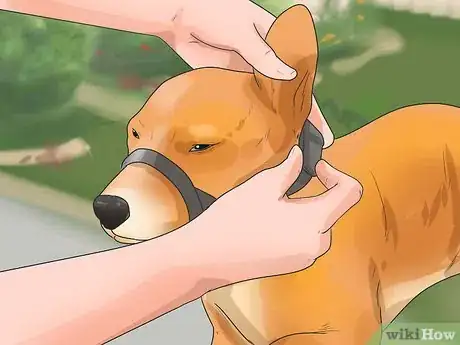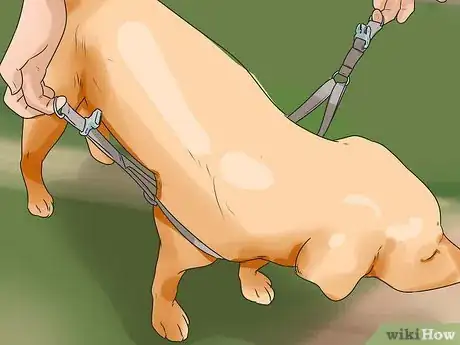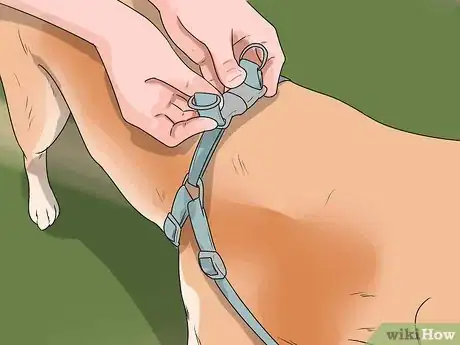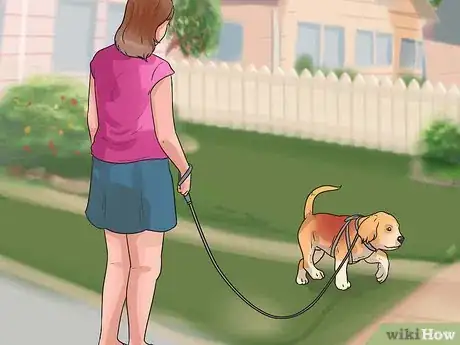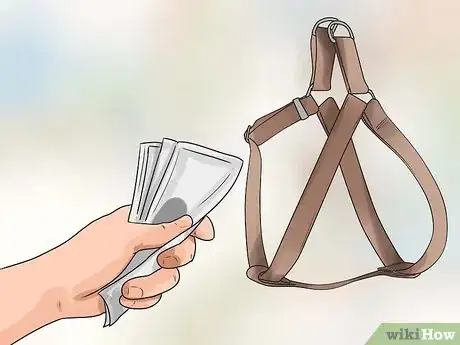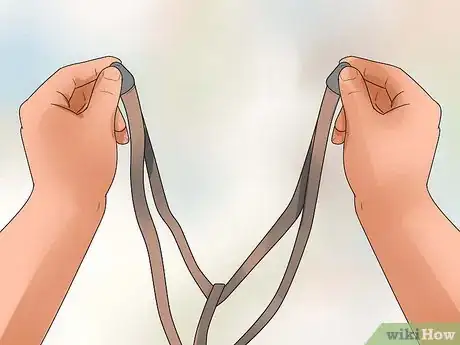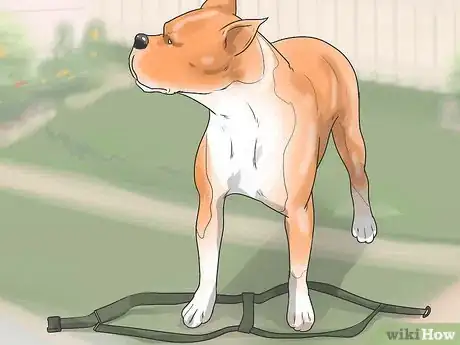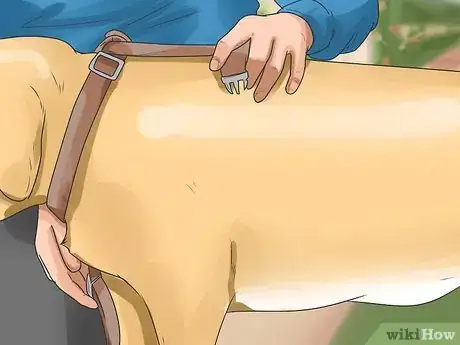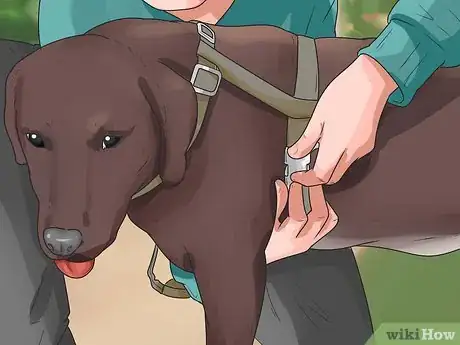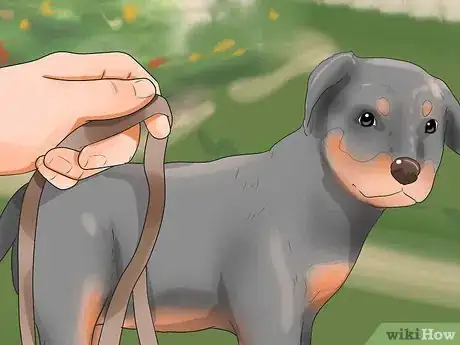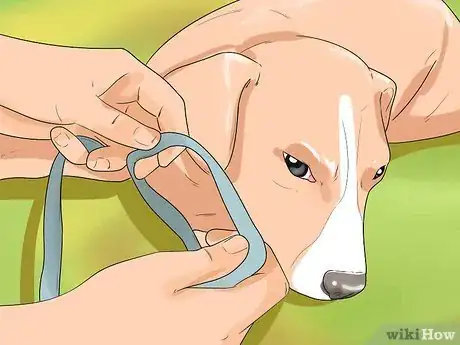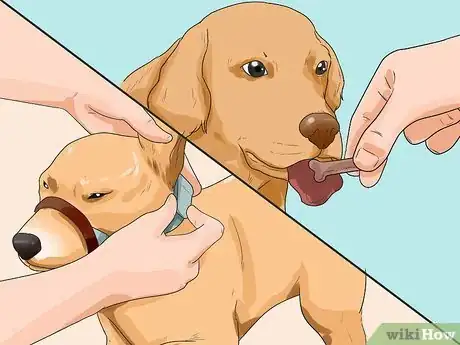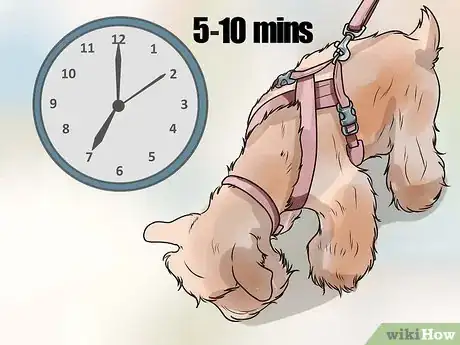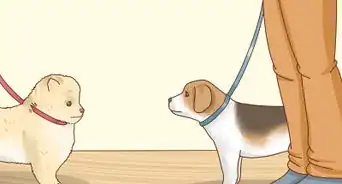This article was co-authored by Ovidiu Stoica. Ovidiu Stoica is a Professional Dog Trainer and the Founder/Owner of NYC Doggies. With over 20 years of professional experience working with dogs, Ovidiu is well versed in providing various dog care services and specializes in dog obedience and behavioral training. Ovidiu and his staff, who have more than 45 years of cumulative experience in the NYC dog walking business, provide personalized dog services including dog training, walking, hiking, boarding, sitting, and puppy care.
This article has been viewed 239,247 times.
A harness is a way to secure your pup so you can take her on daily walks without worrying about her running off. But many dog owners struggle with putting a harness on their puppy, especially if the pup is anxious or uncomfortable with the harness. There are two common types of harnesses: overhead and step in. Once you get the harness on your puppy, you should check to make sure it fits her properly so she will comfortable and happy during her walk.
Steps
Using an Overhead Harness
-
1Purchase an overhead harness. An overhead harness fits over your dog’s head and has straps or tabs that adjust to fit around her belly. Some overhead harnesses also come with chest protection to prevent rubbing and added safety features like reflective trim and a car seat restraint loop.
- Look online for an overhead harness, or at your local pet store.
- You will need to measure your pup’s girth or belly area and her neck area to determine her size.
- Alternatively, you could also take your dog with you when you go shopping for a harness and have your pup try the harness on before you buy it. To confirm the harness fits your dog properly, make sure you can fit at least two fingers between the harness and your dog's body at all points, including her belly and her neck.
- Note that most harnesses are not adequate restraints in a motor vehicle. Do not use a regular harness as a seat belt /restraint unless it specifically says on the packaging that it is designed for this purpose.
-
2Have your dog sit and stay. This will keep her from moving around while you attach the harness. You may also need to ask a friend or partner to hold your dog to keep her still.
- Keep some treats around to reward her once you put on the harness.[1]
Advertisement -
3Let the harness hang loose in your hands. This will help you identify the neck part of the harness. Reassure your pup with a few pets.
-
4Slide your dog’s head through the neck piece. The neck piece will be the large round hole in the middle of the harness. It should be large enough for you to slide it over your dog’s head without squeezing or pulling on her ears or face.
- If it is too small to slide over her head, the harness may be too small for her neck.
-
5Arrange the bottom straps. Slide the straps between your pup's two front legs. The straps should sit between her two front legs, under her belly. They should fit snugly, but not be too short or too tight around your pup’s legs. If the straps don't reach around your pups' belly, they are likely too short and the harness may be too small for her.
-
6Snap the strap buckles together. Reach around your dog's legs and secure the buckles on either side of the harness together. The straps should wrap around your dog's upper belly area.
- Depending on the type of strap buckles your harness has, you may need to simply slide the two pieces together or push one piece through the other piece to secure the buckles.
-
7Adjust the harness to fit your dog. Step back and look at your dog in the harness. Does it look like it is pinching or squeezing her? Does it hang too low on her body? Use the adjustment points, or clips that are attached to the straps, to adjust the harness so it fits her properly.
- It should be snug but also loose enough for you to fit two fingers comfortably between your dog and the harness at any point.
- Test the fit of the harness before you attach the leash to the harness and give your pup a treat for a job well done.
Using a Step In Harness
-
1Purchase a step in harness. A step in harness is great for dogs that go on long walks or hikes. It is a very minimalist design, with a wraparound style that reduces pressure on your dog’s throat. These harnesses have a single buckle over the shoulder, making them easy to put on and take off fast. In most models, the lead is attached to D-rings for an even distribution of pressure on the harness.
- A step in harness with a thinner chest pad is good for dogs who do not like added bulk in their chest area.[2]
- A step in harness with a wider chest pad is good for dogs who don’t mind extra bulk. The wider chest pad will give the harness more comfort and coverage. The wide size will also help to stabilize the harness in case your dog pulls on the leash during the walk.
- Look online for a step in harness, or at your local pet store. Most step in harnesses come in small, medium, and large, depending on the girth or belly measurement of your dog.
- Note that most harnesses are not adequate restraints in a motor vehicle. Do not use a regular harness as a seat belt /restraint unless it specifically says on the packaging that it is designed for this purpose.
-
2Unbuckle the harness and lay it flat on the ground. It should be open, with the top of the buckle facing the ground.
- Keep some treats close by to reward your pup once you put on the harness.[3]
-
3Have your dog stand over the harness. Then, place her left leg in the left loop and her right leg in the right loop.
- You may need to pet her and coax her to stand over the harness. You can also enlist the help of a friend or partner to help you place your dog over the harness.
-
4Secure the straps. Reach around your dog's neck and snap the buckles together over her neck.
-
5Adjust the harness to fit your pup. Step back and look at your dog in the harness. Does it look like it is pinching or squeezing her? Does it hang too low on her body? Use the adjustment points, or clips that are attached to the straps, to adjust the harness so it fits her properly. Most step-in harnesses have adjustment points on either side of the straps around your dog's neck and on the straps around her belly.
- The harness should be snug but also loose enough for you to fit two fingers comfortably between your dog and the harness at any point.
- Test the fit of the harness before you attach the leash to the harness. Only give your pup a treat for a job well done once she is in the harness and ready for a walk.
Getting Your Puppy Used to the Harness
-
1Introduce the harness to your puppy after some playing and petting. Like a collar, your puppy will likely have to get used to wearing a harness. But it can take more time for your puppy to get used to a harness than it did for her to get used to a collar. Some puppies recoil or struggle against the harness. So play with her and pet her for a few minutes before putting on the harness so she is a relaxed, comfortable state of mind.
-
2Attach the harness right away or wait a few seconds before attaching it. Dog owners have differing opinions on whether you should wait before attaching the harness on your pup or just secure it right away. Gauge your puppy’s reaction to the harness. If she recoils from it or struggles against it, pet her for a few seconds before securing the harness. But if she doesn’t seem to mind the harness, secure it right away.
-
3Reward your puppy with a treat once the harness is secure. Don’t give her a treat if she recoils from the harness and you have to remove it. You only want to reward her if she consents to wearing the harness and is ready for a walk.
-
4Let her wear the harness 5-10 minutes a day. This will help her get used to wearing it. Once your pup gets comfortable with the harness, she will look forward to her daily walk and you will look forward to not having to worry about her running off without you.
Expert Q&A
-
QuestionHow do I prepare my puppy for wearing a harness?
 Ovidiu StoicaOvidiu Stoica is a Professional Dog Trainer and the Founder/Owner of NYC Doggies. With over 20 years of professional experience working with dogs, Ovidiu is well versed in providing various dog care services and specializes in dog obedience and behavioral training. Ovidiu and his staff, who have more than 45 years of cumulative experience in the NYC dog walking business, provide personalized dog services including dog training, walking, hiking, boarding, sitting, and puppy care.
Ovidiu StoicaOvidiu Stoica is a Professional Dog Trainer and the Founder/Owner of NYC Doggies. With over 20 years of professional experience working with dogs, Ovidiu is well versed in providing various dog care services and specializes in dog obedience and behavioral training. Ovidiu and his staff, who have more than 45 years of cumulative experience in the NYC dog walking business, provide personalized dog services including dog training, walking, hiking, boarding, sitting, and puppy care.
Professional Dog Trainer Putting any kind of gear on a puppy will be easier if she is properly socialized to touch and gear. A puppy should be comfortable being handled in all sorts of ways—from toes to ears—and this begins as soon as a puppy is brought home. Practice using a collar, harness, and leash every day, gently stick your fingers in her ears and mouth, wiggle her toes, and hold her in different positions. With practice, she will get used to the gear, and she won’t be bothered by things like nail clipping, grooming, and handling.
Putting any kind of gear on a puppy will be easier if she is properly socialized to touch and gear. A puppy should be comfortable being handled in all sorts of ways—from toes to ears—and this begins as soon as a puppy is brought home. Practice using a collar, harness, and leash every day, gently stick your fingers in her ears and mouth, wiggle her toes, and hold her in different positions. With practice, she will get used to the gear, and she won’t be bothered by things like nail clipping, grooming, and handling. -
QuestionAt what age should a puppy wear a harness?
 Pippa Elliott, MRCVSDr. Elliott, BVMS, MRCVS is a veterinarian with over 30 years of experience in veterinary surgery and companion animal practice. She graduated from the University of Glasgow in 1987 with a degree in veterinary medicine and surgery. She has worked at the same animal clinic in her hometown for over 20 years.
Pippa Elliott, MRCVSDr. Elliott, BVMS, MRCVS is a veterinarian with over 30 years of experience in veterinary surgery and companion animal practice. She graduated from the University of Glasgow in 1987 with a degree in veterinary medicine and surgery. She has worked at the same animal clinic in her hometown for over 20 years.
Veterinarian A puppy can wear a harness from when you bring her home, but make sure it fits properly. Don't leave the harness on when she is unattended. However, it's handy to get her comfortable wearing a harness from a young age so you can restrain her in the car, keep control on walks, or monitor her in the house during toilet training.
A puppy can wear a harness from when you bring her home, but make sure it fits properly. Don't leave the harness on when she is unattended. However, it's handy to get her comfortable wearing a harness from a young age so you can restrain her in the car, keep control on walks, or monitor her in the house during toilet training.
References
About This Article
To properly put an overhead hardness on a puppy, have the dog sit and stay, or ask someone else to help you hold the puppy to keep it still. Find the neck part of the harness, or the large round hole in the middle, and slide it over the puppy’s head. Once that’s in place, slide the straps between the dog’s front legs, then wrap the straps up around the dog’s belly and back and snap the buckle together. Adjust the harness so it fits snugly, but is still loose enough that you can slide 2 fingers comfortably between the dog and the harness. For tips from our Veterinary co-author on how to use a step-in harness, keep reading!
